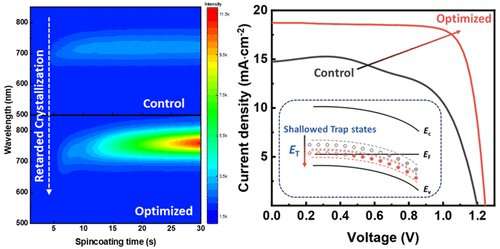Solvent effect on film formation and device performance for 2D Dion-Jacobson perovskite solar cells

Quasi two-dimensional perovskite solar cells (2D PSCs) have received much attention recently due to their unique optoelectronic properties and excellent device stability. Among 2D perovskite, 2D Dion-Jacobson (DJ) perovskite has closer interlayer distance and does not rely on van der Waals interaction between adjacent spacer cations, which can weaken dielectric confinement effect while maintaining its structural stability. Thus, the research interest of 2D DJ PSCs is increasing.
However, due to the high formation energy of 2D DJ perovskite, extra assistance is usually needed during the crystallization process to realize out-of-plane (OOP) crystal orientation and orderly distributed phases, which is essential for promoting carrier transfer and suppressing non-radiative recombination.
Recently, a research group led by Prof. Zhou Huiqiong from National Center for Nanoscience and Technology (NCNST) of the Chinese Academy of Sciences (CAS) has developed a mixed-solvent strategy to study the solvent effect on the film formation and device performance of 2D DJ PSCs. The study was published online in Nano Letters.
The researchers developed a mixed solvent strategy for directly regulating the crystallization process of 2D DJ perovskite by introducing methylamine acetate (MAAc) into precursor with N,N-dimethylformamide (DMF) and dimethylsulfoxide (DMSO). Through in situ photoluminescence (PL) and in situ UV-vis absorption spectra, the nucleation process of perovskite was found to be retarded during the film formation, which can inhibit the excess homogeneous nucleation in precursor and facilitate continuous crystal growth. Due to different nucleation rates of different n-value phases, the films prepared by the ternary solvent strategy realize gradient phase distribution, which is beneficial for carrier transfer between phases.
Benefiting from the enhanced OOP crystal orientation and gradient phase distribution, the traps states in 1,5-pentanediammonium (PeDA) based 2D DJ PSCs are greatly shallowed (from 0.276–0.510 eV to 0.133–0.367 eV) and the non-radiative recombination energy loss is suppressed (from 0.151 eV to 0.126 eV). As a benefit, a highest reported open circuit voltage (VOC = 1.25 V) in 2D DJ PSCs was realized. The device also exhibited great heat tolerance, which maintains 80% of its initial efficiency after being kept in 85 °C after 3000 h.
The in-situ observation of crystallization process allows people to deeply understand the mechanism of crystallization regulation via solvent effect. This mixed-solvent strategy can be helpful to the work focusing on perovskite solar cells.
More information: Gaosheng Huang et al, Solvent Effect on Film Formation and Trap States of Two-Dimensional Dion–Jacobson Perovskite, Nano Letters (2022). DOI: 10.1021/acs.nanolett.2c02533
Journal information: Nano Letters
Provided by Chinese Academy of Sciences





















